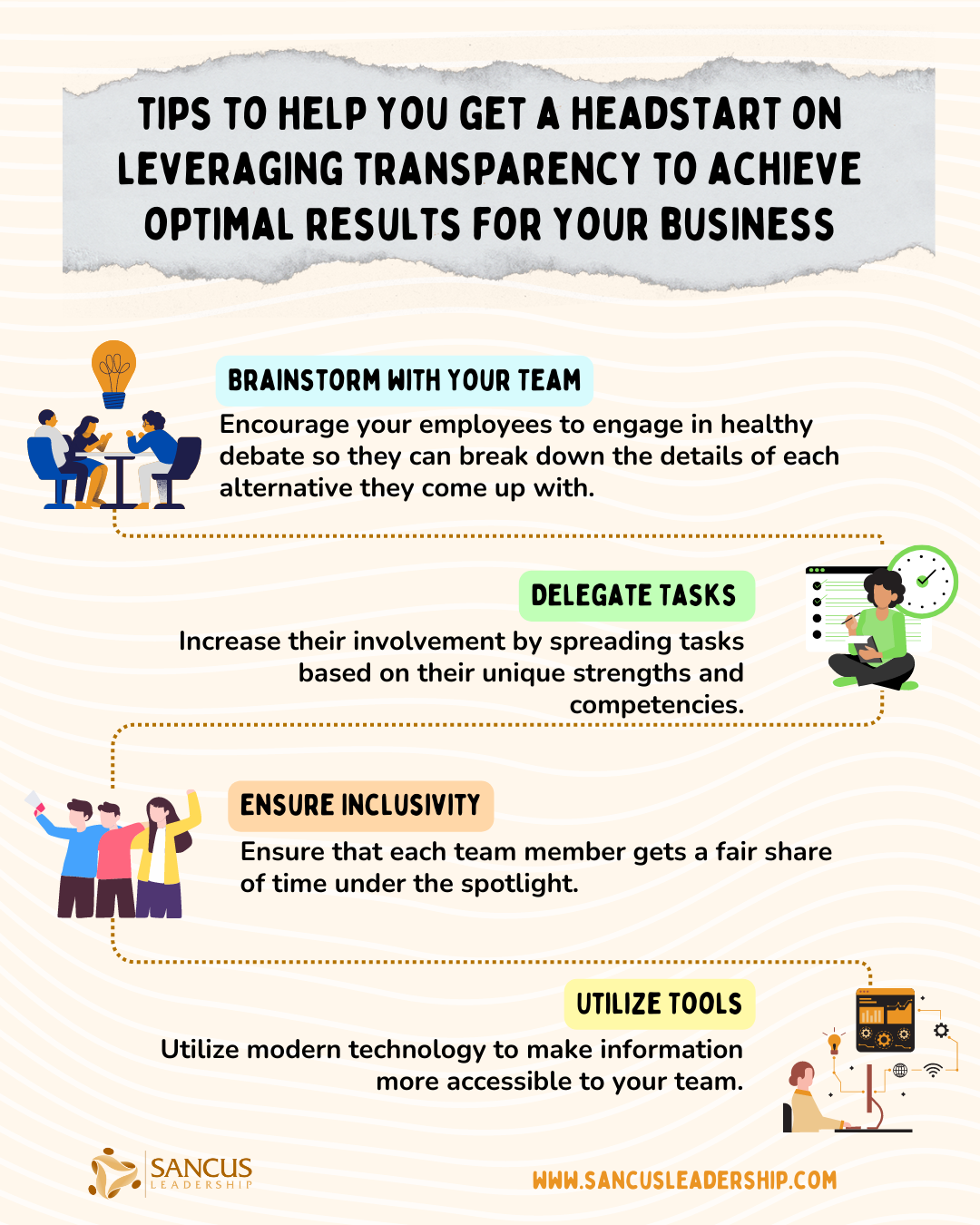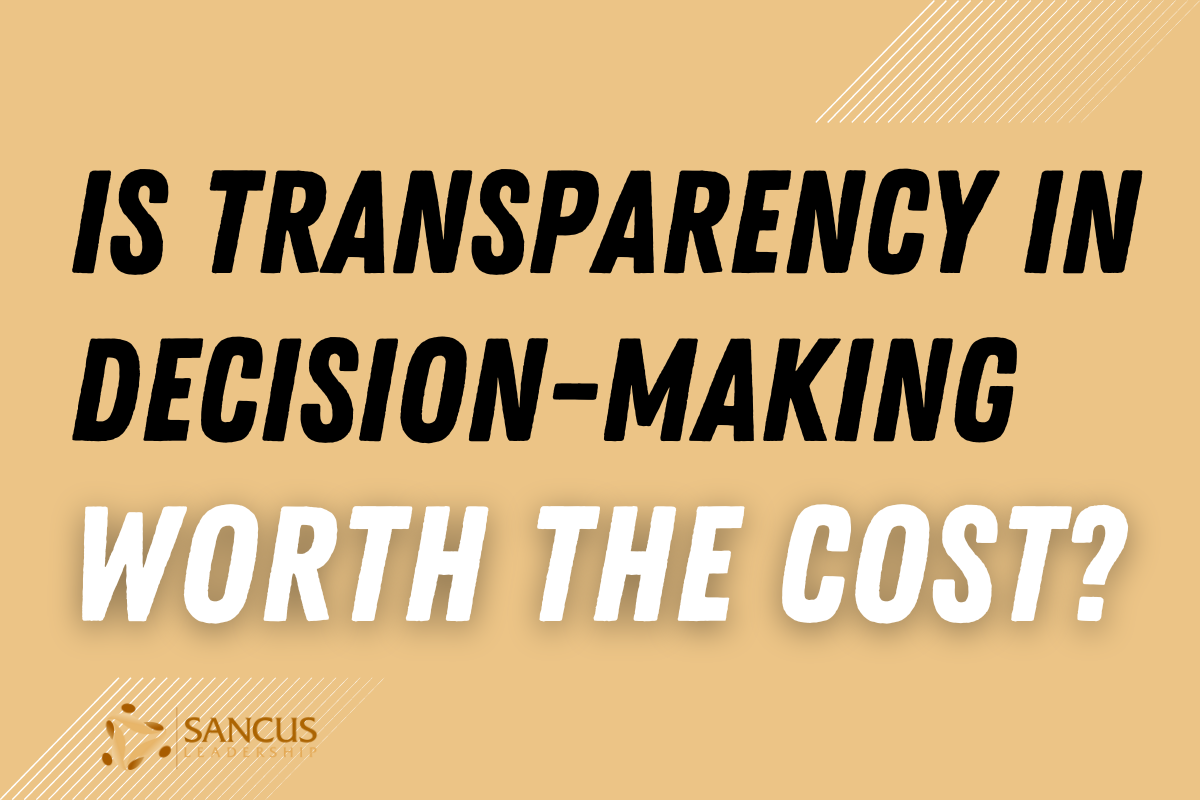Are you hesitating about increasing transparency in your decision-making process simply because it involves too many risks? Perils are involved, but the danger is that you inadvertently deprive your team of the opportunity to thrive and achieve their full potential. This is why you must encourage a collaborative culture in the workplace where honesty and transparency are at the forefront.
Transparency in decision-making is worth the cost since the benefits you reap are manifold and highly promotive of a more stable, successful company. It’s a great way to retain the best people and attract top-quality workers to join your team. It’s also a tool to boost efficiency and productivity.
This article looks at the risks involved in incorporating transparency in the workplace and why these risks are worth taking simply because the consequences of non-transparency are highly detrimental to business productivity and stability. The benefits of an open, honest culture will be highlighted, along with some tips on seamlessly transitioning to a more engaging, inclusive, and collaborative team. Let’s begin.
Risks Involved in Transparent Decision-Making

Many leaders hesitate about transparent leadership, particularly concerning decision-making, because it exposes them to various risks. Some find it easier not to challenge the status quo — a team structure where employees look to their leaders for directives on where the team is headed and how each member should contribute to help it get there.
Many leaders hesitate about transparent leadership, particularly concerning decision-making, because it exposes them to various risks.
The cost of incorporating transparency in the workplace that most leaders are worried about includes:
- Losing a firm hold on the team. Some leaders equate managing a team to complete control of practically all business operations. When you practice transparency, you risk losing control over how the team functions and how goals are achieved.
- Bandwagon effect. Involving a team of diverse individuals in decision-making will give rise to various opinions and ideas. The danger here is that the group might favor the popular alternative rather than the most fitting one.
- Conflicts. Energetic arguments and heated discussions are inevitable when you engage individuals from different backgrounds, armed with varied skill sets, and possess distinct personalities in transparent decision-making.
Is It Worth the Risks? The 6 Consequences of Non-Transparency

By all appearances, this simple, traditional structure seems efficient and rational. However, the consequences can be highly detrimental to your business in the long run, especially in today’s modern era, where more and more employees thrive in an open, engaging work environment.
Here are some of the repercussions of a non-transparent work culture:
- The grapevine will thrive. Employees will resort to speculating and gossiping among themselves when there is a glaring lack of information in the workplace. This leads to false information, inaccurate conjectures, and unhealthy relationships within the team.
- Team dishonesty. Employees will need to conceal information, especially their mistakes, due to fear of their weaknesses being exposed or a lack of trust in their leaders.
- Micromanaging. Leaders tend to micromanage their team when there is a lack of transparency and feel the need to control practically every aspect of the business entirely. According to a survey, 68% of workers who have worked with micromanaging leaders experienced a significant decrease in their morale, while 55% noted a dip in their productivity.
- Low employee morale. Employees who don’t feel trusted, valued, and appreciated start feeling dissatisfied about work. This makes them disengage from the team, bringing about reduced levels of productivity.
- High employee turnover. When your team members feel unhappy and dissatisfied about their jobs, they will start looking for greener pastures. A high turnover rate disrupts business operations and entails extra costs concerning hiring and training new people.
- Misdirection. Employees must be fully aware of team goals and are likelier to stray away and eventually disengage entirely from the team. Transparency is a great tool to ensure all employees’ efforts align with the company’s goals.
8 Benefits of Transparency in Decision-Making

Suppose you want to enhance your business’s communication, collaboration, employee morale, and productivity. In that case, one way to do so will guarantee almost instant results — by incorporating transparency in your leadership style, particularly in the decision-making process. Employees will immediately sense changes in the work environment and will undoubtedly respond positively to your efforts.
Here are some of the benefits you can look forward to by simply encouraging a more open, transparent vibe at work:
- Blindspots are addressed. The varying perspectives of unique individuals can result in conflicts within the team. Still, if you are proficient in managing these scenarios, you’ll end up with alternatives you probably would never be able to come up with if you had decided to do things all by yourself.
- Smoother implementation. There will be minimal to no resistance when implementing the alternative chosen by the team. After all, they were actively involved in the decision-making process. This also results in a more substantial commitment to the plan until the goal is sufficiently achieved.
- Stronger ownership. Your employees will feel highly accountable for the decisions the team arrives at. They’ve weighed both pros and cons and are aware of the risks and consequences they’re faced with.
- High employee engagement. Your team members will feel more inspired to contribute to the team when they see that you consider them your allies in business and not just your followers. According to a survey, 71% of workers perceive employee engagement as one of the determinants of a business’s success.
- Higher employee morale. Employee morale soars when they feel seen, heard, and valued.
- Boosted productivity. When employees know exactly where the business is, where it’s headed, and how they fit into the picture, they are driven to excel. This is also a common reaction when they aren’t blind-sided by the abrupt implementation of decisions made solely by their leader.
- Higher employee retention rate. Employees want to work with leaders who see their worth and push them to achieve their full potential. If you keep your team members happy in their work, they will find no reason to leave the company. High employee retention rates also equate to higher engagement and productivity.
- Enhanced corporate appeal. Word gets around fast, and when the industry knows how rewarding it is to be part of your team, you’ll soon see a long line of top-quality, highly skilled workers eager to contribute to your business’ success.
| Benefits of a more open, transparent vibe at work | Description |
| Blindspots are addressed | This increased sharing of information helps to illuminate those blindspots that might otherwise hinder effective decision-making and collaboration. |
| Smoother implementation | This clarity helps prevent misunderstandings and reduces the chances of misaligned efforts that can lead to delays or errors during implementation. |
| Stronger ownership | This clarity empowers them to take greater ownership of their tasks and projects. They are more likely to view their work as meaningful and impactful, driving them to invest their time and effort more wholeheartedly. |
| High employee engagement | When employees are kept informed about company strategies, goals, and changes, they are more likely to feel included and respected. |
| Higher employee morale | With a clear understanding of goals, expectations, and project details, employees can direct their efforts more efficiently toward achieving desired outcomes. |
| Boosted productivity | With a clear understanding of goals, expectations, and project details, employees can direct their efforts more efficiently towards achieving desired outcomes. |
| Higher employee retention rate | A transparent and open work culture contributes to higher employee retention rates by fostering trust, managing expectations, and promoting a sense of empowerment and value. |
| Enhanced corporate appeal | When a company is forthcoming about its practices, products, and services, it establishes a reputation for reliability and credibility. |
4 Ways To Ensure Gainful Transparency in Decision-Making

With all the benefits associated with workplace transparency, it’s unsurprising that more and more businesses are adopting this type of company culture. We at Sancus Leadership believe in empowering employees to strive for excellence continuously.
With all the benefits associated with workplace transparency, it’s unsurprising that more and more businesses are adopting this type of company culture.
Book a call with us now to find out how to achieve peak employee satisfaction through workplace transparency!
Simon Sinek, in this interview, talks about why transparency is critical to creating trust in an organization.
Here are some tips to help you get a headstart on leveraging transparency to achieve optimal results for your business:
1. Brainstorm with Your Team
Encourage your employees to engage in healthy debate so they can break down the details of each alternative they come up with. Their varying backgrounds, skills, experiences, and perspectives will all come into play, so your team comes up with various options.
Make a list of pros and cons for each alternative and properly scrutinize each point. This strategy is one of the best ways to eliminate unsuitable solutions and highlight those that provide the best opportunities for the business.
2. Delegate Tasks
Inviting your team to a discussion is not enough to ultimately develop the best alternatives for specific issues in the company. It would also be great if you could increase their involvement by spreading tasks based on their unique strengths and competencies.
For instance, if a team member is exceptionally adept at researching, think about assigning that person to head a small team that gathers information on specific topics relevant to the decisions that need to be made.
If a team member is skilled in the arts, consider utilizing their talents in visual representations of ideas presented to help make essential details more unambiguous and relatable to the rest of the team.
If there’s someone you perceive to be great at handling finances, why not allocate a specific budget and trust them to wisely spend organizational funds without seeking your approval for each purchase?
Delegating tasks will show your employees that you trust and value the unique skills and acquired experiences they bring to the table. The added responsibilities will boost their self-confidence, empowering them to always strive for excellence.
3. Ensure Inclusivity
Ensure that each team member gets a fair share of time under the spotlight. Remember, they come from different backgrounds and are equipped with diverse skills and experiences that can help broaden your perspectives on various subjects. Ensure each opinion is heard, suggestions are considered, and all viewpoints are recognized. This way, your employees will feel that you respect and value them.
When everyone has a voice in the team, employees feel empowered and inspired to step out of their comfort zone constantly. They will want to expand their horizons, work toward their true potential, and push themselves to always exceed themselves, performing better and better with each opportunity.
4. Utilize Tools
Modern technology equips us with handy tools to help enhance transparency in the workplace. You can utilize these to make information more accessible to your team. These are also great avenues for them to reach out to you in a faster, more convenient way.
Here are some options to consider
- Cloverpop (partner with Sancus Leadership)
- Slack
- Kudos
- Monday.com (what we use for project management)
- ClickUp
- Asana

Key Takeaways
Transparency in decision-making may seem daunting to some leaders, particularly those who favor the traditional, tried-and-true structure where practically all directives come from them. Sharing the reins with team members may seem unnerving to some.
However, incorporating transparency in your leadership is just what your company needs, especially now when there’s strong evidence that the best employees appreciate being heard, valued, and engaged in critical business operations. Inclusivity in the decision-making process will make your employees more invested in the business, inspiring them to aim for excellence in their work continually.



